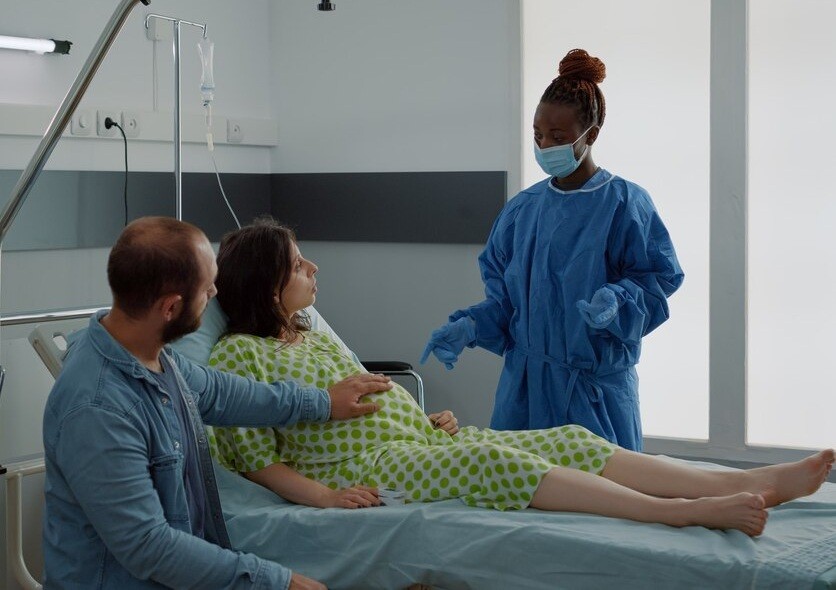As pregnant women enter the third trimester, it’s important to prepare for labor while remaining mindful of possible complications. Although the due date is approaching, there are still risks and warning signs to monitor in the final stages of pregnancy. Below is a breakdown of these risks.
Risks of Third Trimester Pregnancy Complication
Complications can arise during any trimester, including the third. Recognizing the symptoms and potential risks during this period can aid in preventing or managing complications effectively.
Here are some complications to look out for in the third trimester:
Gestational Diabetes
This condition involves elevated blood sugar levels that develop only during pregnancy, typically identified between 24 and 28 weeks. It is caused by hormonal changes that affect how the body processes sugar, resulting in high blood glucose levels.
Symptoms include:
- Frequent urination
- Excessive thirst
- Fatigue
- Nausea
If left untreated, gestational diabetes can lead to further complications, such as preeclampsia and the need for a cesarean section.
Preeclampsia
Preeclampsia is marked by high blood pressure, excess protein in the urine, or signs of organ damage. It can develop after 20 weeks of pregnancy. If not properly managed, preeclampsia poses a risk of severe complications for both the mother and fetus.
Premature Rupture of Membranes (PROM)
While membrane rupture is a normal part of labor, when it happens too early—before labor begins—it can lead to complications for the baby. Premature rupture of membranes typically occurs before 37 weeks.
Potential risks for the baby include:
- Respiratory issues and underdeveloped lungs
- Brain hemorrhage
- Placental abruption (when the placenta detaches prematurely)
- Compression of the umbilical cord
Premature Birth
Premature birth occurs when labor begins before 37 weeks of pregnancy. The earlier the birth, the greater the health risks for the baby. Premature infants often require care in a Neonatal Intensive Care Unit (NICU).
If you experience symptoms such as frequent contractions, persistent lower back pain, mild cramps, light bleeding, or ruptured membranes during the third trimester, you should see a doctor immediately.
Intrauterine Growth Restriction (IUGR)
IUGR refers to a condition where the baby’s growth is restricted in the womb, leading to a smaller-than-normal fetus. Causes of IUGR vary but may include:
- Placental abnormalities
- Twin pregnancy
- History of IUGR in previous pregnancies
- Anemia, high blood pressure, or heart disease in the mother
- Chronic conditions like diabetes, kidney disease, or autoimmune disorders
Understanding the potential complications and their warning signs during the third trimester can help pregnant women safeguard their health and that of their baby. Regular check-ups with a healthcare provider are essential for ensuring a healthy pregnancy and delivery.
If you have questions about your pregnancy, consult an obstetrician or use the consultation feature on the Ai Care app, available on the App Store and Play Store.
Looking for more health tips, first aid advice, and home remedies? Click here!
- dr Nadia Opmalina
Primary Care. Third-Trimester Pregnancy Complications. Available from: https://www.primarycare.theclinics.com/article/S0095-4543(11)00092-3/abstract
Cleveland Clinic. Preganncy Complications. Available from: https://my.clevelandclinic.org/health/articles/24442-pregnancy-complications
Dulay, A. (2024). Prelabor Rupture of Membranes (PROM). Available from: https://www.msdmanuals.com/home/women-s-health-issues/complications-of-pregnancy/prelabor-rupture-of-membranes-prom
Mayo Clinic. Preeclampsia. Available from: https://www.mayoclinic.org/diseases-conditions/preeclampsia/symptoms-causes/syc-20355745
Mayo Clinic. Gestational Diabetes. Available from: https://www.mayoclinic.org/diseases-conditions/gestational-diabetes/symptoms-causes/syc-20355339
Cleveland Clinic. Intrauterine Growth Restriction. Available from: https://my.clevelandclinic.org/health/diseases/24017-intrauterine-growth-restriction












